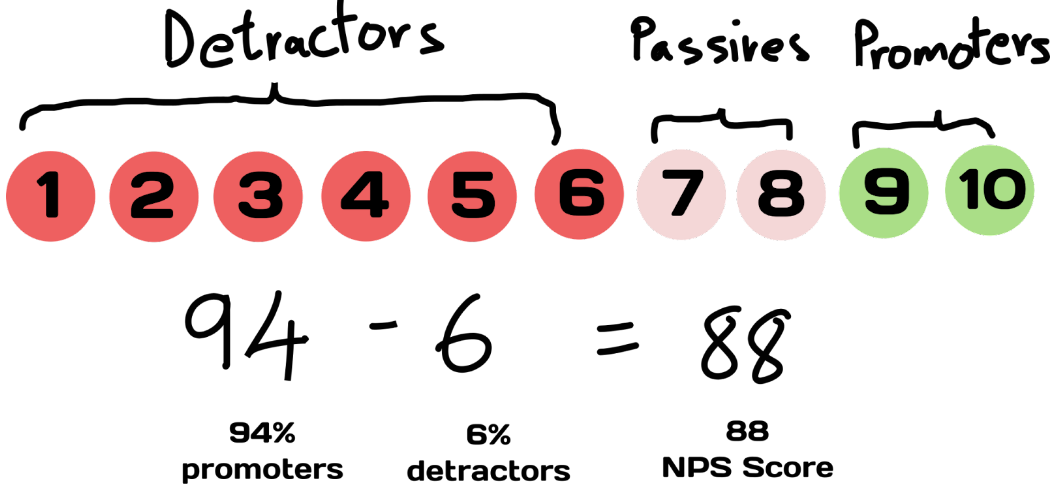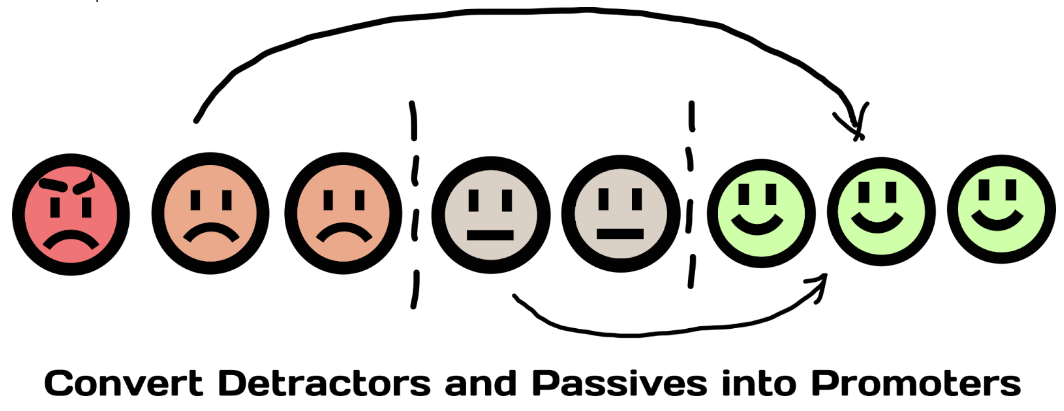How to calculate NPS Automatically from Unstructured Customer Feedback
- Last Updated
- Last Updated -

Table of Contents
- What is NPS (Net Promoter Score)?
- How to Calculate NPS?
- Why are NPS scores important?
- How to improve NPS scores?
- 1. Gather Customer Feedback
- 2. Analyze Customer Feedback
- 3. Enhance Customer Experience
- 4. Foster a data-driven Customer-Centric Culture
- What are the issues with NPS scores?
- NPS Best Practices
- Conclusion
- How can Freetext AI help?
Understanding and measuring customer satisfaction is critical for success in today's competitive business landscape. One widely-used metric for gauging satisfaction and loyalty is the Net Promoter Score (NPS). In this blog, we'll delve into what NPS scores are, how to calculate NPS scores, and strategies to improve them.
We will also look at the shortcomings of NPS scores and also explore the role of sentiment analysis in understanding customer feedback.
So, let's dive in and unlock the true potential of NPS scores!

What is NPS (Net Promoter Score)?
Net Promoter Score (NPS) is a customer satisfaction metric that helps businesses gauge their customers’ loyalty. NPS scores range from -100 to 100 and provide a snapshot of customers' likelihood to recommend a brand, product, or service to others. By analyzing NPS scores, businesses can identify areas of improvement and enhance their customer experience. NPS enables customer success management to better understand customer sentiment and take data-driven actions to improve satisfaction and loyalty. As a result, NPS becomes a pivotal tool for customer success teams in fostering strong, long-lasting relationships with their customers.
How to Calculate NPS?
To calculate NPS, businesses survey their customers with the following question:
"On a scale of 0-10, how likely are you to recommend [brand/product/service] to a friend or colleague?"

Based on their responses, customers are categorized into three groups:
- Detractors (0-6): Unhappy customers who may discourage others from trying the product or service
- Passives (7-8): Satisfied but indifferent customers who could be swayed by competitors
- Promoters (9-10): Loyal enthusiasts who will actively promote the brand to others
The NPS score is then calculated using this formula:
NPS = (% of Promoters - % of Detractors)
For example, if a company has 40% promoters, 20% passives, and 40% detractors, the NPS would be (40% - 40%) = 0.
Why are NPS scores important?
NPS scores are valuable for several reasons.
The most important reason is that it gives customer facing teams one single metric to track the overall health of the company. By monitoring NPS, Customer Success Managers can quickly identify at-risk accounts and take proactive steps to address concerns and improve relationships. NPS data can be used to pinpoint trends in customer feedback, helping customer success teams better understand their clients' needs and tailor their services accordingly.
Tracking NPS scores over time allows companies to measure the impact of their efforts and make data-driven decisions. Additionally, high NPS scores correlate with increased customer retention and revenue growth, making them a crucial metric for business success.
How to improve NPS scores?

The way to increase NPS is blatantly obvious - convert your Detractors and Passives into Promoters while keeping the current set of Promoters intact. The challenge for any successful NPS program (and business) lies in being able to execute this.
1. Gather Customer Feedback
To enhance NPS scores, it is essential to collect customer feedback from a wide array of sources. This includes valuable inputs from online reviews, customer feedback on social media platforms, and other channels. When crafting customer surveys, it is crucial to incorporate free-form textual feedback from customers to gather comprehensive insights.
2. Analyze Customer Feedback
Data without insights holds little value. In the past, analyzing extensive amounts of customer feedback was a laborious process. Fortunately, with the advent of AI-powered tools (like Freetext AI 😉), it is now feasible to efficiently analyze vast quantities of customer feedback, extracting valuable insights from the data.
3. Enhance Customer Experience
Improving customer experience is vital for boosting NPS scores and fostering customer success. To begin, focus on resolving prevalent pain points by leveraging topic and sentiment analysis. This enables a deeper understanding of customer feedback and emotions. Prioritize incoming feedback and incorporate common customer pain points into a roadmap aimed at rectifying the customer journey.
4. Foster a data-driven Customer-Centric Culture
Encourage employees to take ownership of customer satisfaction by fostering a customer-centric culture within your organization. This is particularly important for customer success teams, as their primary goal is to ensure customers achieve their desired outcomes with your product or service. Reward and recognize employees who contribute to positive customer experiences, and regularly share NPS results to maintain focus on the importance of customer satisfaction. By cultivating a culture that prioritizes the customer, you create an environment where both customer success and high NPS scores can flourish.
What are the issues with NPS scores?
1. Lack of finer grained sentiment
NPS scores fail to provide detailed insights on detractors, as they do not differentiate between different segments within this category. For instance, let's consider Company A and Company B, each having the same number of the promoters and 250 detractors each. Despite the possibility that Company A's detractors are all extremely dissatisfied customers, while Company B's detractors are moderately unhappy, both companies would be assigned the same NPS score.
2. Lack of additional information
NPS scores serve as a high-level metric, serving as a guiding star for customer teams. However, in order to import NPS and genuinely enhance customer satisfaction, it is crucial to go beyond the confines of NPS scores alone. This is where additional sources of feedback, such as free-text feedback from customers, become invaluable in driving meaningful improvements.
NPS Best Practices
To get the most out of your NPS surveys, follow these best practices:
Design surveys that are easy to understand and complete
Distribute surveys at optimal times to ensure maximum response rates
Set realistic goals for improvement and track your progress
Leverage textual feedback
Textual feedback is free from the constraints of survey biases. It allows more expressibility for the customer, allowing you to capture more data about customer sentiment.
A key aspect of understanding customer feedback is multi-channel analysis, such as with Freetext AI. The platform allows you to analyze unstructured feedback data from various channels (social media, emails, surveys, etc.) and gain valuable insights into customer sentiment. By leveraging Freetext AI, you can better understand customer opinions and preferences, enabling you to make informed decisions to improve satisfaction and boost your NPS score.
Conclusion
By understanding NPS scores and implementing strategies to improve them, your business can reap the rewards of increased customer loyalty and retention. For Customer Success Managers, leveraging NPS data and sentiment analysis is essential for identifying customer needs and ensuring their success with your product or service.
However, NPS scores are just a starting point. Continuous improvement and adaptation are key to maintaining high NPS scores and a successful business. So always be open to refining your business based on customer feedback!
How can Freetext AI help?
If you're looking to dynamically track NPS from unstructured customer feedback - CRM, emails, tickets, chats, reviews, tweets, surveys & more - Freetext AI's LLM-powered platform can help with the following:
- Feedback Analysis
- AI identified topics + Sentiment analysis
- No manual tagging or custom training required
- Automated Report Generation
- Dynamic CSAT, NPS scores from unstructured feedback
- Single Source of Feedback
- ... and more!
Get in touch for a personalized demo!